Remember When
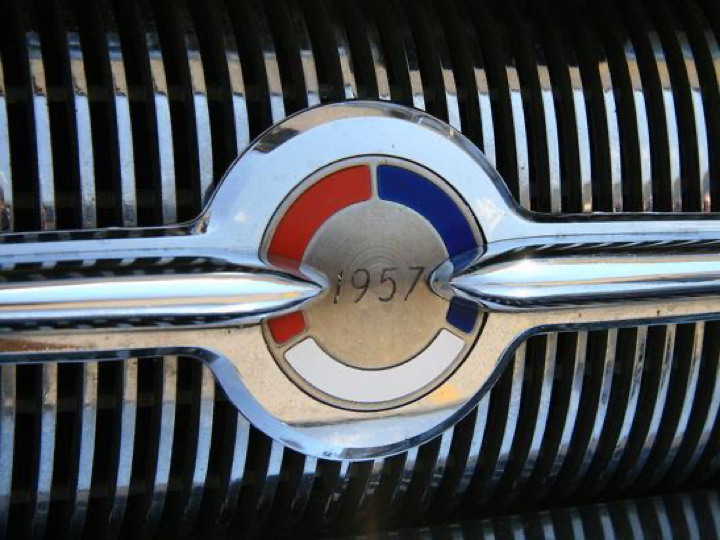
TOURING AMERICA 1957
The year was 1957. Most of us weren’t old enough to drive yet, but we couldn’t wait to get behind the wheel of our own car. It was the beginning of the greatest period in US automotive history – a time when the debut of new cars in the showrooms was one of the biggest events of the year. Life was good and America was prosperous. World War II was twelve years in the past and the Korean War had been over for four years. President Eisenhower had signed the Interstate Highway System into law and freeways were under construction all over the country. America was on the move.
The pages that follow are an abbreviated trip back to 1957 and some images of what life was like at a time when people were discovering this great country, getting out on the highways to explore not only the beautiful geography, but to engage in new forms of recreation. Crossing the United States from Maine to Southern California and from the Pacific Northwest to Florida, this brief peek in the rear view mirror brings back some fond memories of days when a few bucks went a long way; when people were proud of their country; and when summertime was a time for discovery and adventure.
American cars were stylish, comfortable, powerful, and colorful. And, for most people, they were affordable. A new car carried an average price tag of under $2400. A good used car could be purchased for under $500. Gas was $.24 per gallon, and rent was an average $90 per month. Though most families thrived at just $5000 per year, women were entering the work force, so average family incomes were climbing to $10,000 per year or more, and families were beginning to take advantage of a booming new segment of the post war economy – recreation.
We’re going to take a little ride across America now, and hopefully the journey will bring back some pleasant memories of the days when we were young teenagers, seeing the world, not on the tiny screen of a cellular phone, but firsthand as we lived it to the fullest. Regardless of where we grew up, there was so much to see and do.
The year was 1957. Most of us weren’t old enough to drive yet, but we couldn’t wait to get behind the wheel of our own car. It was the beginning of the greatest period in US automotive history – a time when the debut of new cars in the showrooms was one of the biggest events of the year. Life was good and America was prosperous. World War II was twelve years in the past and the Korean War had been over for four years. President Eisenhower had signed the Interstate Highway System into law and freeways were under construction all over the country. America was on the move.
The pages that follow are an abbreviated trip back to 1957 and some images of what life was like at a time when people were discovering this great country, getting out on the highways to explore not only the beautiful geography, but to engage in new forms of recreation. Crossing the United States from Maine to Southern California and from the Pacific Northwest to Florida, this brief peek in the rear view mirror brings back some fond memories of days when a few bucks went a long way; when people were proud of their country; and when summertime was a time for discovery and adventure.
American cars were stylish, comfortable, powerful, and colorful. And, for most people, they were affordable. A new car carried an average price tag of under $2400. A good used car could be purchased for under $500. Gas was $.24 per gallon, and rent was an average $90 per month. Though most families thrived at just $5000 per year, women were entering the work force, so average family incomes were climbing to $10,000 per year or more, and families were beginning to take advantage of a booming new segment of the post war economy – recreation.
We’re going to take a little ride across America now, and hopefully the journey will bring back some pleasant memories of the days when we were young teenagers, seeing the world, not on the tiny screen of a cellular phone, but firsthand as we lived it to the fullest. Regardless of where we grew up, there was so much to see and do.
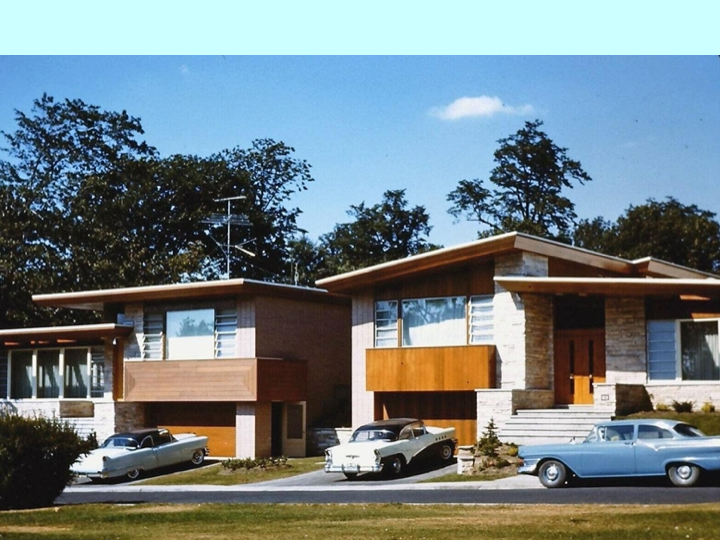
Suburban areas were growing fast. The cost of an average new home was under $15,000 and most families had a car that was less than 5 years old. Split level homes were the trend and many families had color television sets (note antenna).
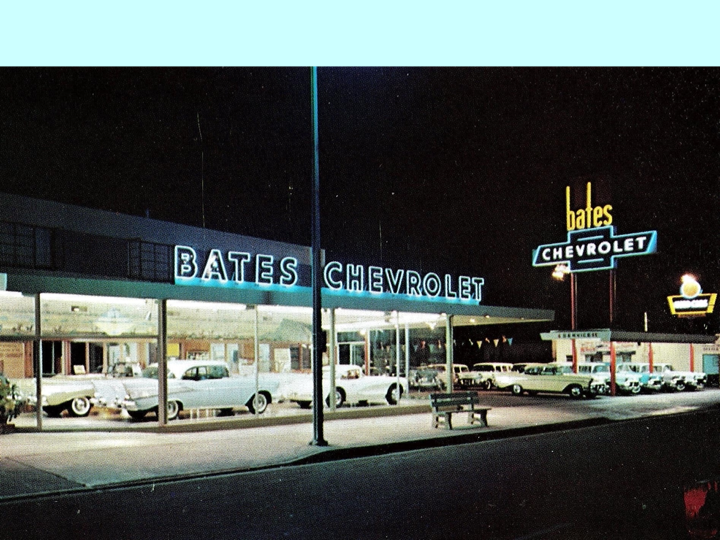
The 1957 Chevrolet was among the most desired cars of all time. There was a huge variety of models, color combinations, and power options. Though no one knew it at the time, this would become the most iconic of all vintage cars and they would be as desirable decades later as they were when new on the showroom floors.
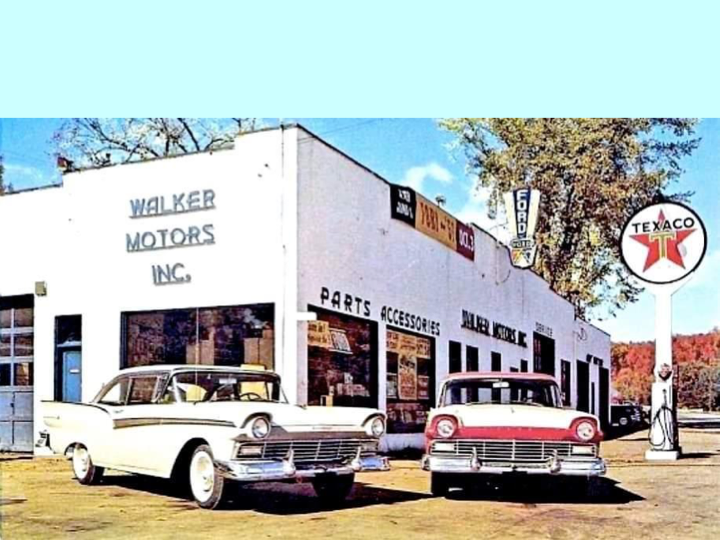
Ironically, Ford outsold Chevy in 1957 – for the first time since 1935. Ford pedaled just under 1.7 million Ford units compared to slightly over 1.5 million Chevrolet units sold. Total US auto production soared to 6.2 million cars and trucks. That meant that one family in six purchased a new car in that year. Low interest automobile financing became available to most people, meaning a new car could be bought with little down payment and monthly installments of less than $75. At the top of the scale, Lincoln introduced the Continental Mark II personal coupe at $10,000 but was eclipsed by Cadillac when the ultra luxurious Eldorado Brougham premiered at a little over $13,000.
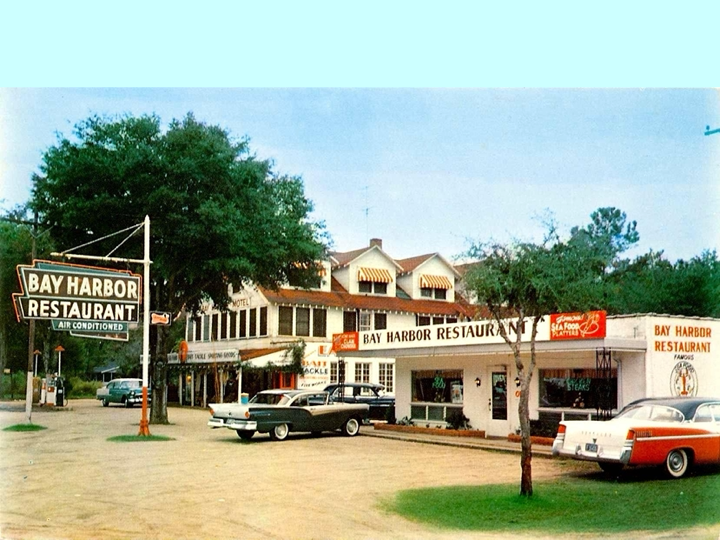
Summertime meant vacation time. People took to the highways and byways to enjoy their favorite pastimes, especially water sports. Activities like boating, camping and water sports were popular from coast to coast. The Great Lakes drew huge crowds and the newly opened Mackinac Bridge joined the upper peninsula of Michigan with the lower peninsula. Resorts and restaurants blossomed to handle the increase in summer tourism.
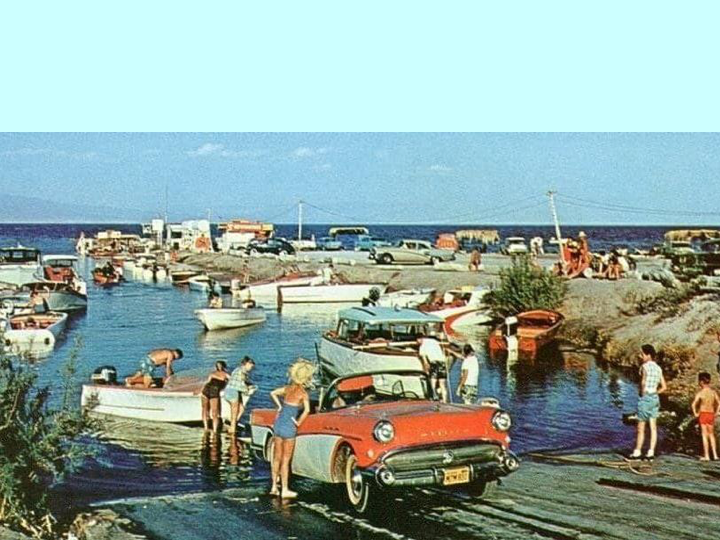
The mid-50s were a time when many families had a boat, and summer meant crowded boat launch ramps and marinas. While sailing continued to be popular in areas where boats could be docked or moored, water skiing was the favorite pastime of young families. Advances in fiberglass made small powerboats more affordable for the middle class, and being much easier to transport and maneuver than wooden boats, they had great appeal. Outboard motors grew in size and horsepower to meet the increased demand. Daytripping to the nearest lake for a day of boating and picnicking was a great way to spend the summer.
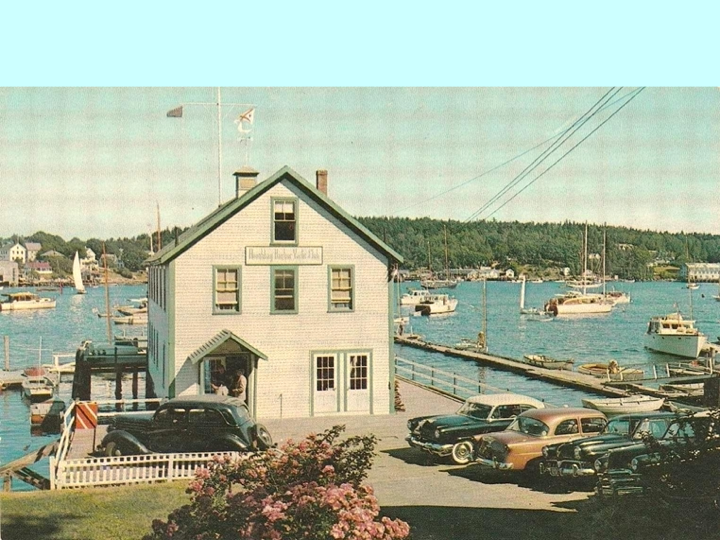
As winter releases its grip on New England, sailing and boating at picturesque harbors like Boothbay, Camden, Five Islands, Stonington, and Bar Harbor in Maine get busy by Memorial Day and stay that way until the sun sets on Labor Day. Yachts from all the ports on the Eastern Seaboard make their way north to enjoy the quiet, cool days of summer in the northeast corner of the Union.
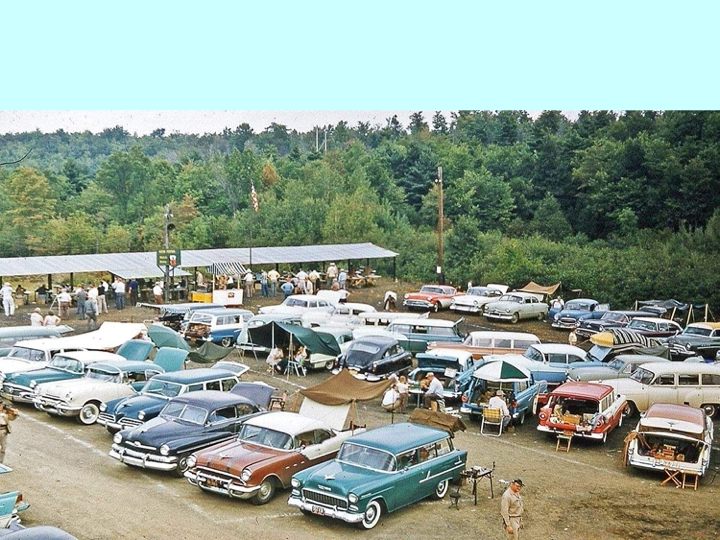
What could be a better way to spend a summer weekend than to join one or two hundred of your friends at the shooting range for some tailgate picnicking, a few cold adult beverages, and blasting clay pigeons out of the sky? Whether you are down south in Georgia or up in the Palouse of Idaho, the sweet sound of a 12 gauge shotgun and the acrid odor of cordite wafting through the air gets an ol’ boy hungry for some fried chicken and cold beer.
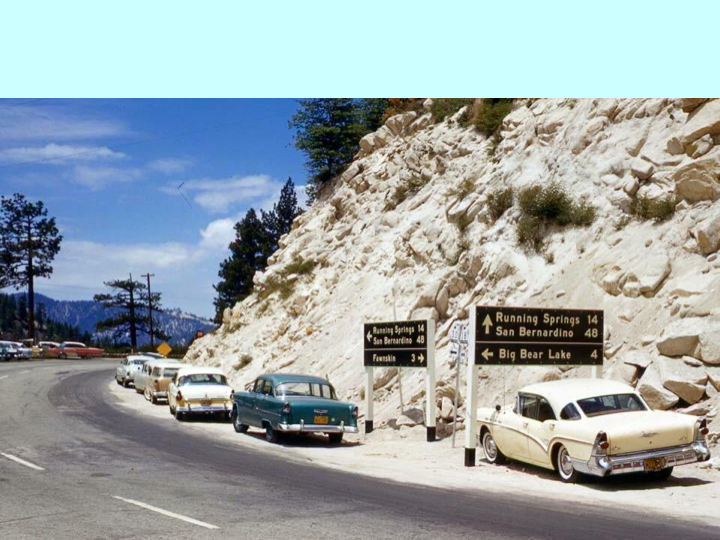
Summertime in Los Angeles back in 1957 meant smog tinted tangerine skies and temperatures in the 90s. Escape from the city of two million people meant heading for the mountains for some people. Nearby Mount Baldy, Lake Arrowhead, and Big Bear Lake were only a couple of hours away, a scenic drive on twisty mountain roads. The land was still affordable enough to have a cabin in the woods. Few thought about the future and none would have guessed that the population of Los Angeles County would exceed the million people in just sixty years.
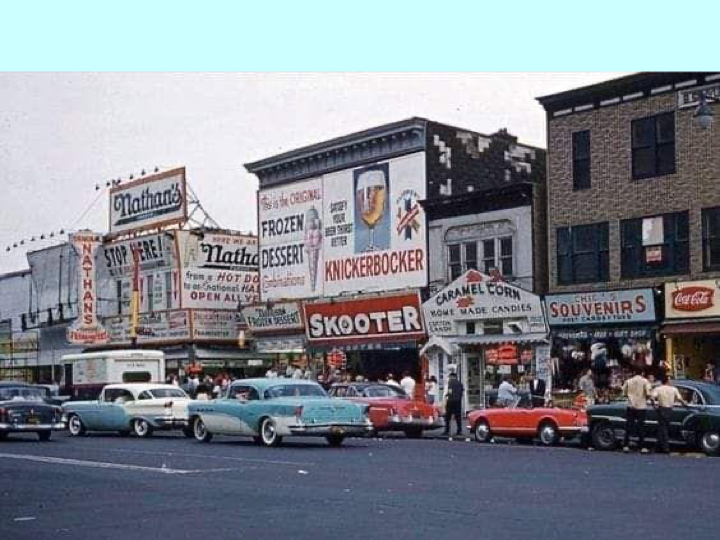
New Yorkers flocked to Coney Island when the summer months arrived. “Down the shore” the boardwalk attracted hundreds of thousands of people and the sand was barely visible for the colorful bloom of beach umbrellas. Iconic Nathan’s HotDog holds a hot dog eating contest every year on Independence Day. Legend has it that the contest started in 1916. In 2021, a hundred and five years later, the winner downed 76 dogs in ten minutes.
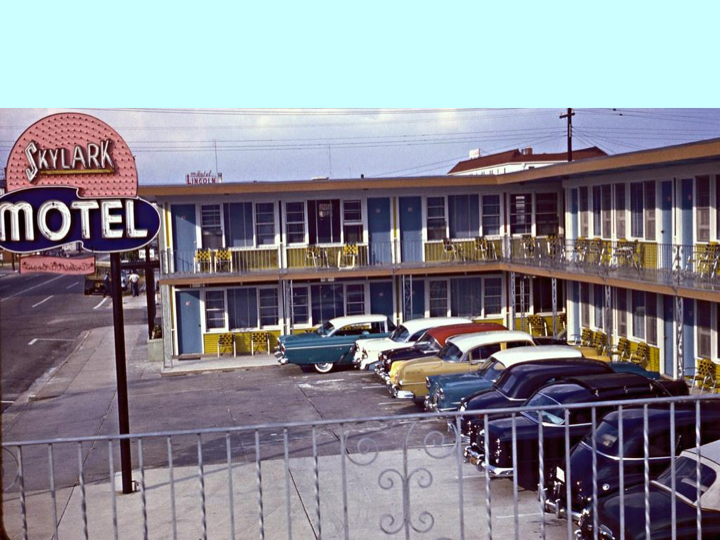
In Atlantic City, New Jersey, the Atlantic shore drew thousands of people every weekend to their famous boardwalk, and to the Steel Pier where they could watch Arabian stallions dive from a 60 foot high platform into the salty water. At that time, there were no casinos, and the ocean was the biggest attraction. Besides the diving horses, the six story tall elephant named Lucy, constructed of wood and tin in 1861 in nearby Margate was a big thrill for kids. Since there were no big resorts, small motels flourished. Resorts International opened the first casino in 1978 and everything changed.
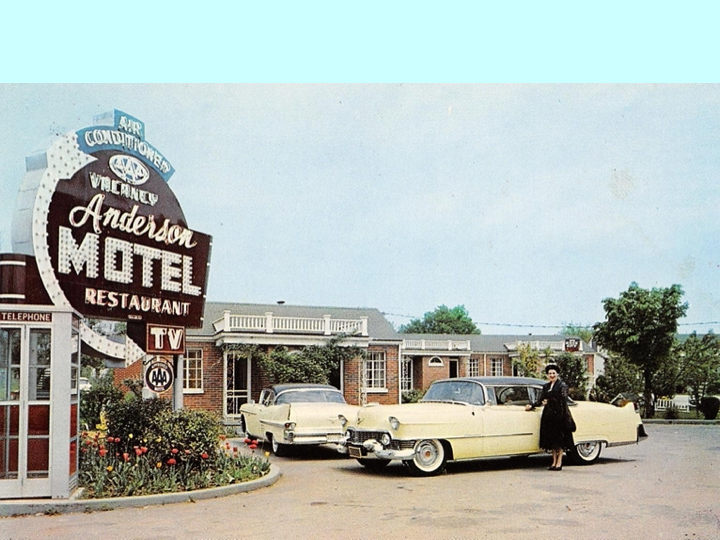
The expanding mobility of Americans and new interstate freeways spawned the exponential growth of the MO-TEL. All across the United States, roadside motor inns that provided travelers with economical lodging popped up along every highway. Startup companies with names like Holiday Inn, Ramada Inn, Howard Johnson’s, and Rodeway Inn began to buy up local Ma and Pa motels and offer upgrades like TV and air conditioning.
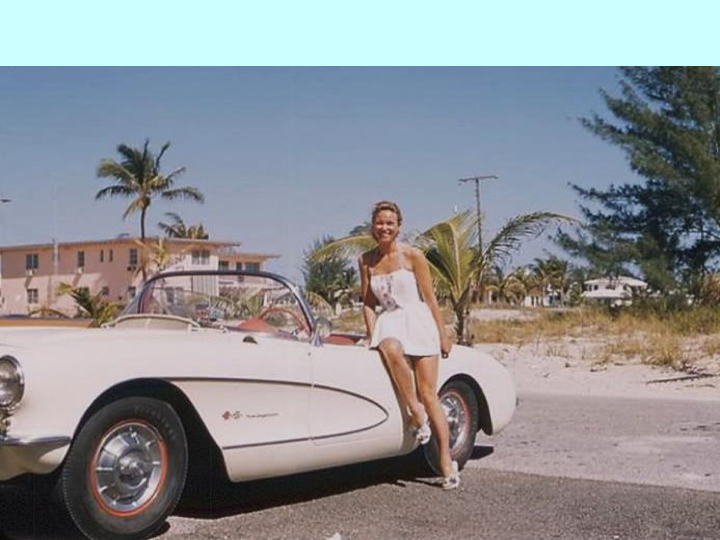
America’s sports car, the Chevrolet Corvette, made its debut in 1953. In 1955, the 150 horsepower Blue Flame six cylinder inline engine was replaced by the V8. In 1957, the first solid lifter, fuel injected engines were released, making 283 horsepower from a displacement of 283 cubic inches. Girls loved the Corvettes more than the guys that drove ‘em.
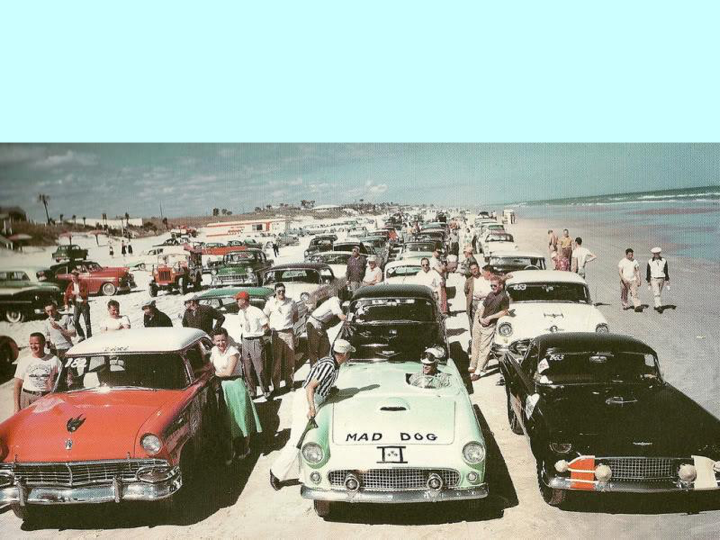
It is said that the first automobile race happened the day the second car was made. Americans, more than any nation other than, perhaps, Italy, love racing cars, and by the mid-50s, street racing was commonplace. This straight line form of racing became known as “drag racing” since it started on the main streets, or “main drags” of nearly every town. Seeing a need for safety and sanctioned timing of these races, pioneer Wally Parks formed the National Hot Rod Association in 1951 in Southern California. NHRA took hold on dry lake beds in the West, but it was several years before sanctioned quarter mile drag strips appeared in the rest of the country. On the East Coast, the beach at Daytona, Florida was a summer drag racing venue where hundreds of drivers would show up, often in a car that just came from the dealer showroom, to see what it would do. NHRA drag racing now draws the largest crowds in motor racing with 11,000 horsepower top fuel dragsters reaching speeds in excess of 335 mph in under 4 seconds.
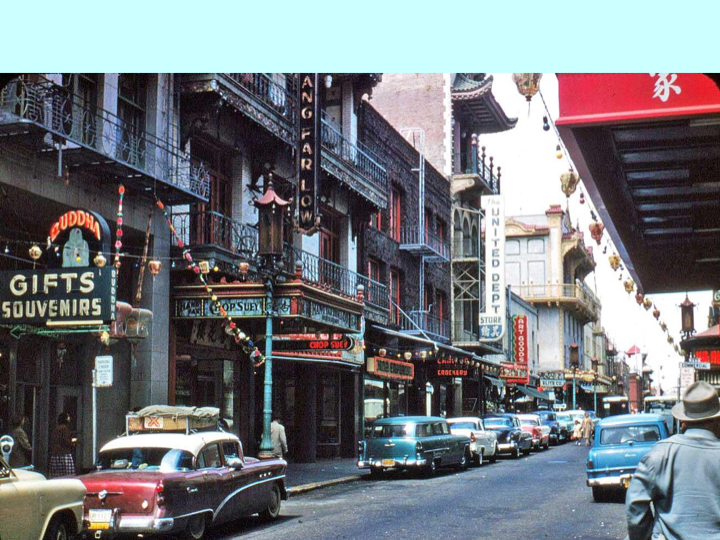
Before Tony Bennett topped the charts with his song “I Left My Heart in San Francisco” in 1962, the beautiful City by the Bay was drawing tourists from all over the world. Fisherman’s Wharf, Chinatown, the cable cars, winding Lombard Street, the “painted ladies” Victorian houses, and the Golden Gate Bridge were beckoning visitors. A coat was advised. Mark Twain said, “The coldest winter I ever spent was a summer in San Francisco.”
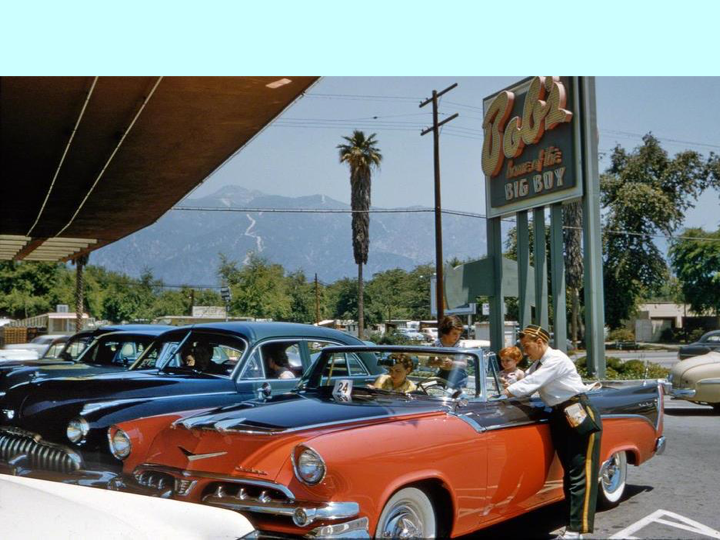
Big cars with fins were in. Chrysler Corp had the most pronounced aquarian appendages on the hallmark Chryslers, Imperials, DeSotos, Dodges, and Plymouths. Cadillacs, of course, Pontiacs, and even the ubiquitous Chevys led the fin parade for GM, and Fords, Mercurys and Lincolns sported them, too. Lesser known marques – Studebaker, Packard, and even American Motors models fell in line with this styling trend. Today, they are extremely collectible.
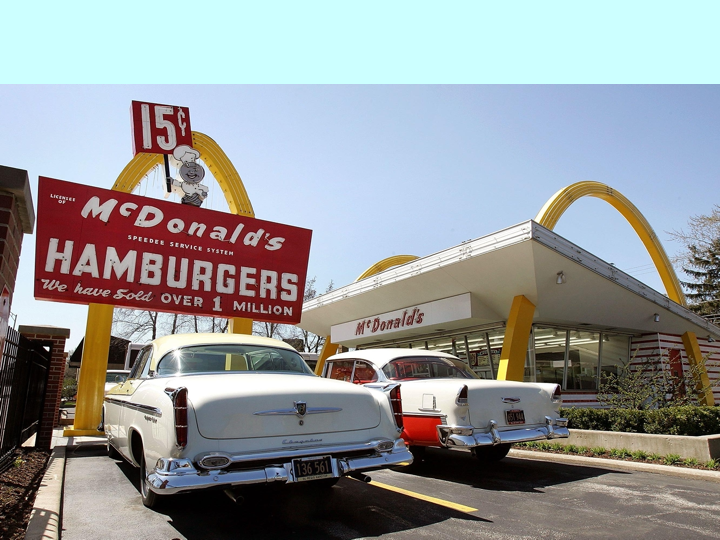
A more mobile America meant fast food on the go. Nobody cashed in on the cheap, quick, edible burger and fries joints like McDonalds. For under 40 cents the Mickey D outlet put a hamburger, fries, and a Coke on your tray. It would be years before other fast food franchises would begin to present any competition for Ray Kroc ’s empire. Started in 1955, by 1957 the company advertised over a million burgers sold. They quit counting after 40 yrs. Estimated 300 billion now
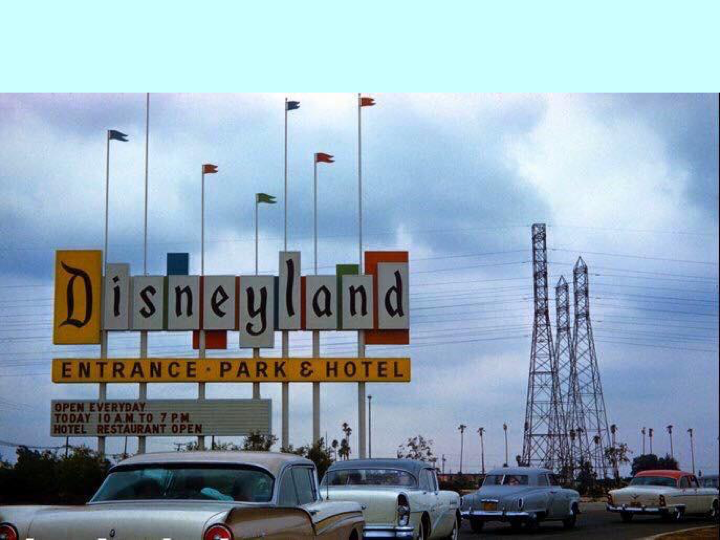
Walt Disney brought Disneyland to the world in 1955 in Anaheim. The most loved theme park in the world charged an admission of $1 for adults and 50 cents for kids then. Amusement rides were 10 cents to 35 cents. A family of four could spend the day there for under $10, including food. By the summer of 1957 the price had quadrupled, but included ride tickets (A,B,C). The E Ticket rides didn’t appear until 1959. So, you might ask, how much does it cost now? An adult day pass has just passed the $200 mark for 2022. Figure about $1000 per day for dad, mom, and a couple of kiddies.
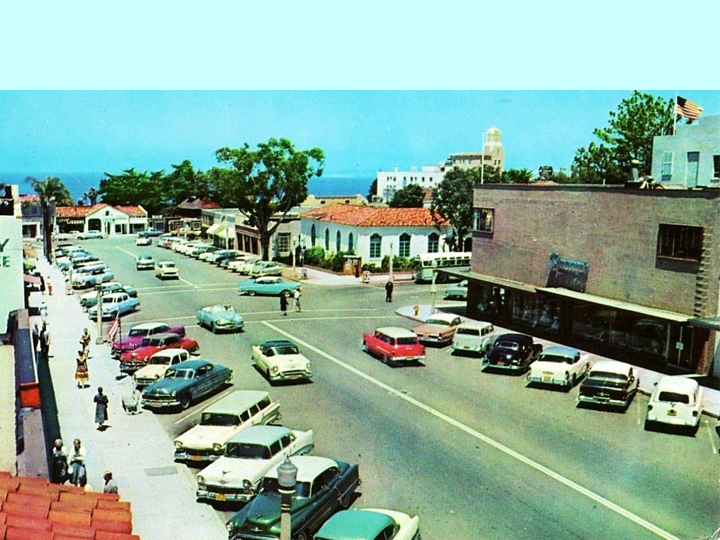
Further south, down near the Mexican border, the port city of San Diego was beginning to get tourist trade. Primarily a Navy town, the old Gaslamp district, then known as the Stingaree, catered to the debauchery of sailors on shore leave, but about the only tourist draw, except for the beautiful coast and great weather, was the San Diego Zoo in Balboa Park. The zoo brought thousands in the summer, and soon the trendy coastal enclave of La Jolla began to blossom.
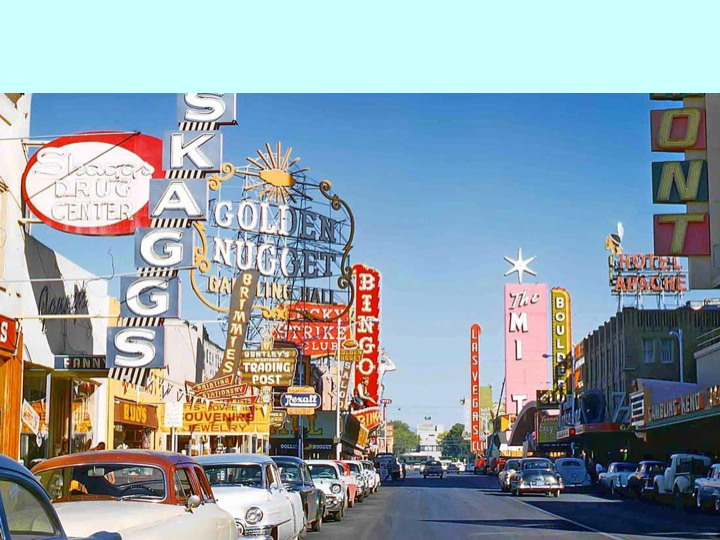
In the blazing heat of Southern Nevada, the gambling mecca of Las Vegas began to sprout its roots and grow. Sin City was no longer confined to the downtown Fremont Street gambling parlors , The Las Vegas Strip became home to high rise resorts, with star entertainment, huge swimming pools, and fancy restaurants. Ignited by Bugsy Siegel’s Flamingo, the strip exploded with new places like the Dunes, the Sands, and the Riviera. People loved seeing the antics of Dean Martin, Frank Sinatra, Sammy Davis, Jr., Joey Bishop and ad hoc members of their impromptu show. By 1957 they were known as the Rat Pack.
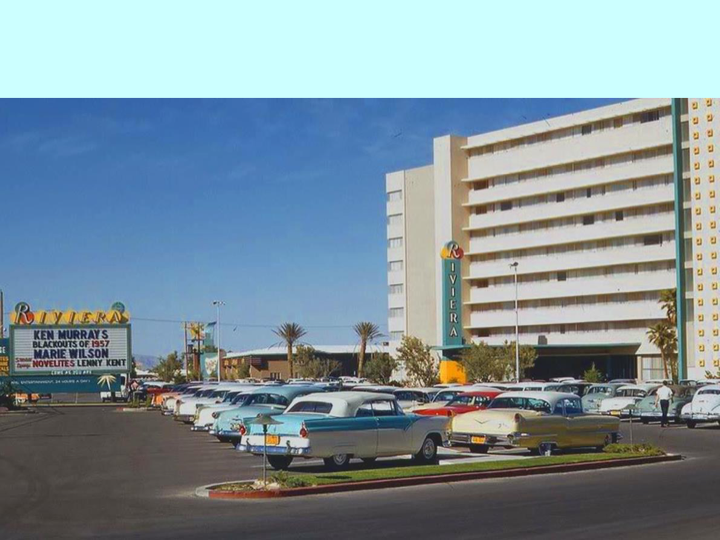
Before the days of parking structures, people left their cars out in the blazing heat of asphalt parking lots. Second degree burns were not unusual when unsuspecting tourists from cooler climes left their money in the slot machines and grabbed for the door handles of their cars to leave. Gambling fever swept the country after Las Vegas became a national tourist destination. One story tells of a man who was asked how he did at the tables. “Great!” he said, “I got here in a $4000 Cadillac and I’m leaving on a $30,000 bus.”
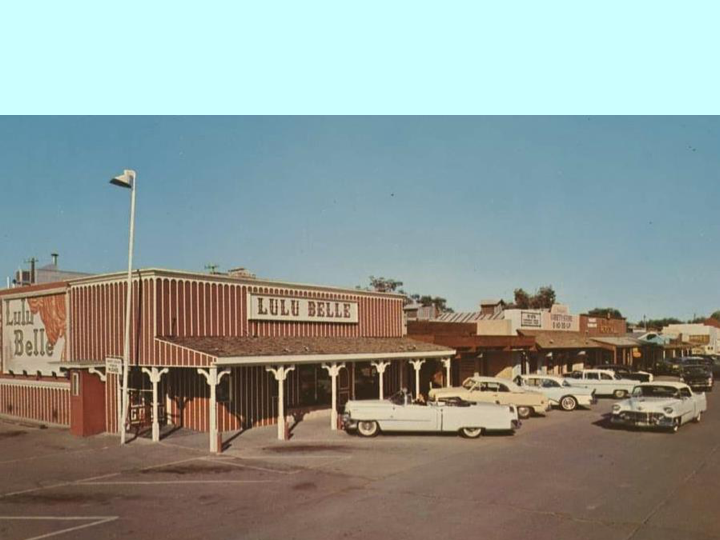
Summer in the Valley of the Sun is hell. But, folks still went to Arizona in the summer to enjoy the Sonora desert heat and soak up some Old West flavor. Scottsdale was a little outpost to the east of Phoenix that learned early how to lure in the tourists with western wear, Navajo jewelry, art fairs, and, of course, golf. Convertibles were common because auto air conditioning was an expensive option and rain was rare. Out of town a little ways, a place called the Pinnacle Peak Steakhouse was popular. When unsuspecting customers came through the door wearing a tie, it was immediately snipped off and nailed to the ceiling, all in good fun.
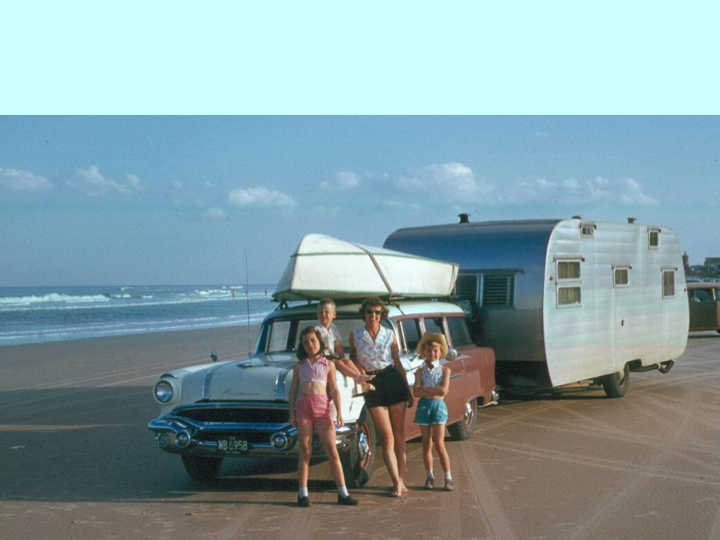
Up on the central California coast, beach camping was a family affair. At Pismo Beach, hundreds of vehicles ventured out onto the sand and weekend cities of tents and trailers popped up. Though newcomers were advised to be sure to pitch camp on the dry sand above the high tide line, it was a common occurrence to see travel trailers doing a pretty fair imitation of the houseboats that appeared four years earlier and were just beginning to show up at lakes around the country. The Pacific Ocean is still the main California attraction, and Pismo Beach is the only beach today that allows cars on the sand.
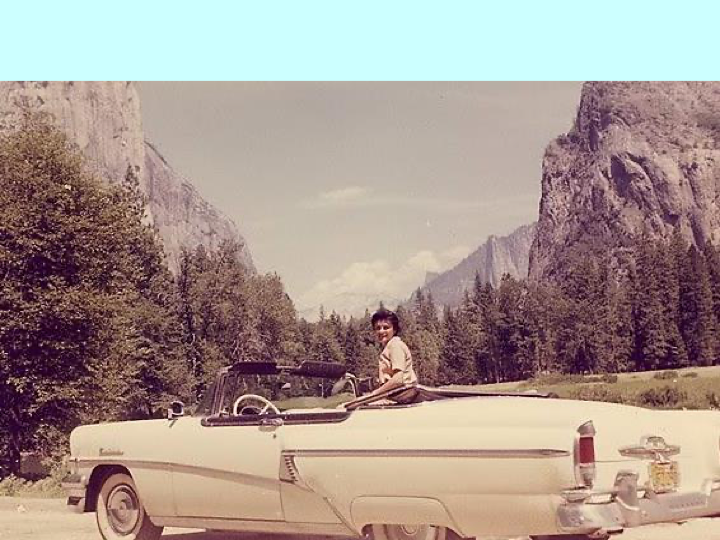
In Eugene, Oregon the main drag was Willamette Street, a one way heading southbound. When the sun went down, this was often an impromptu drag strip from light to light, not unlike the scenes from the movie “American Grafitti”. Twenty years later, the town council turned this street into a pedestrians only, effectively killing all downtown commerce. Hot, sultry days were the norm in July and August, with plenty of rain the rest of the year. Today, the Willamette valley, from Eugene to Portland, is a top varietal wine producing region with over 900 wineries.
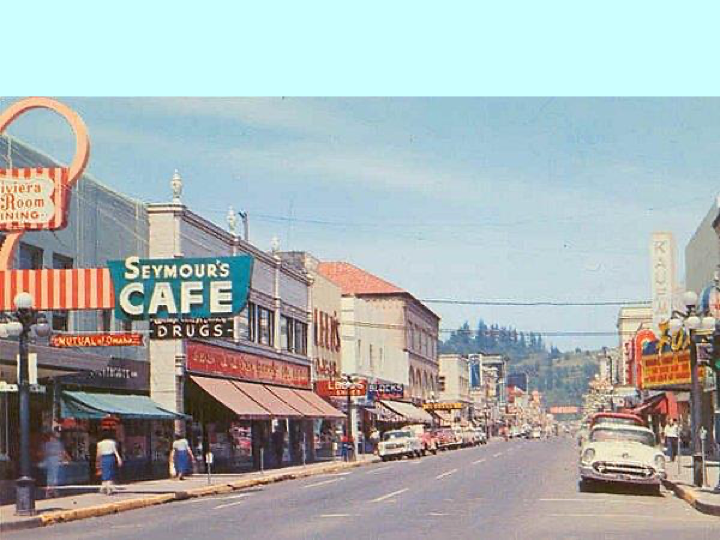
The mid-50s motoring public needed gasoline for their colorful, stylish cars. At that time gas prices were as low as $.15 per gallon in many places and uniformed attendants at gas stations pumped gas, cleaned the windshield and checked the oil while the tank was being filled. Many “service stations” as gas stations were called, offered auto repair services.
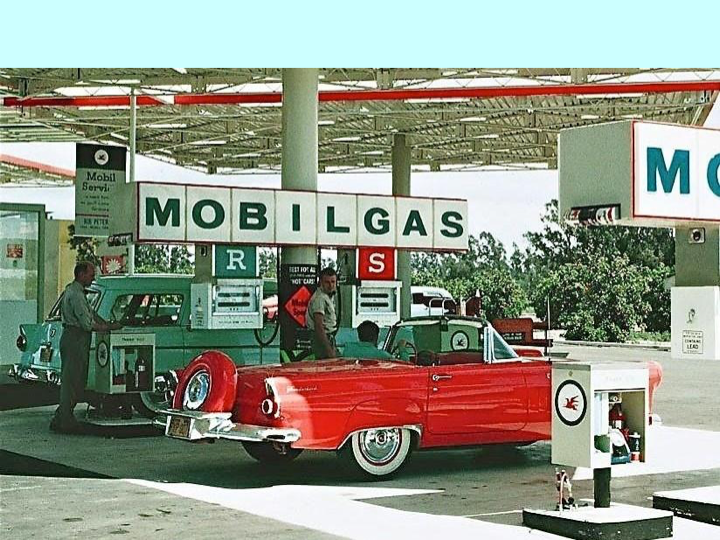
The mid-50s motoring public needed gasoline for their colorful, stylish cars. At that time gas prices were as low as $.15 per gallon in many places and uniformed attendants at gas stations pumped gas, cleaned the windshield and checked the oil while the tank was being filled. Many “service stations” as gas stations were called, offered auto repair services.
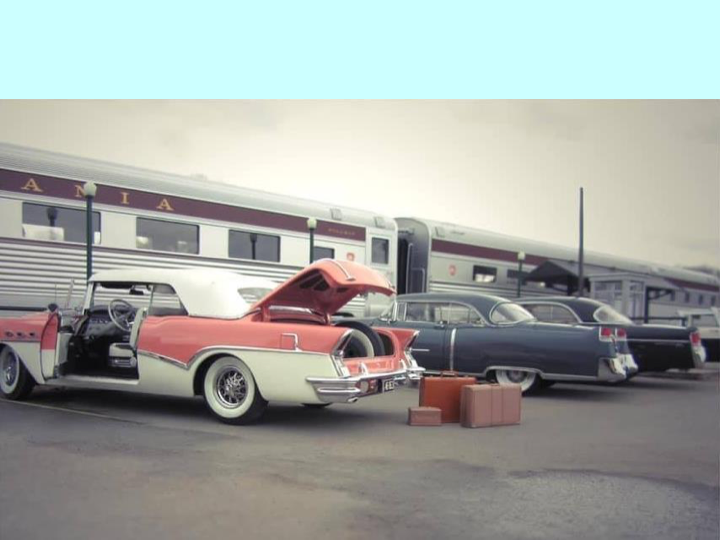
Though America was undergoing the dynamic changes to automotive travel as new interstate freeways began to connect all corners of the country, travel by rail was still the way most people traveled from coast to coast, or for any long distances. Prior to the days of Amtrak, railroad companies offered passenger service ranging from basic low cost accommodation to luxurious suites with first class meals. Steam locomotives had mostly been replaced with diesel engines by this time, and scenic train vacations were commonplace.
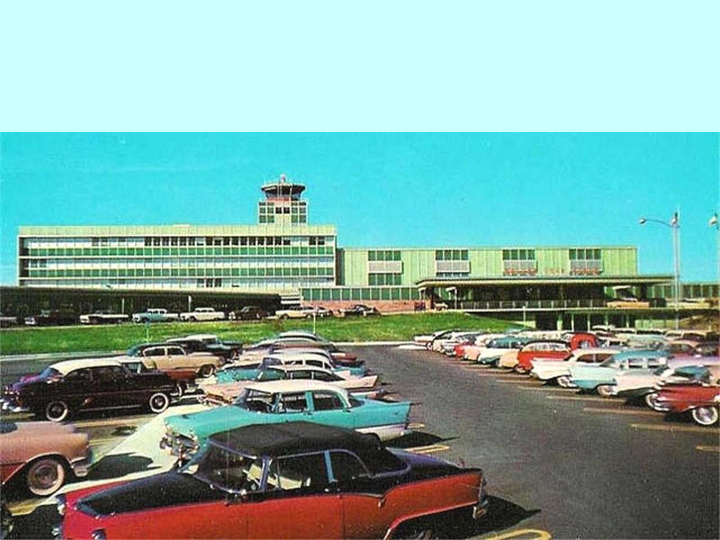
Air travel in 1957 was generally not something the average family could afford. By the end of the decade, however, jet aircraft entered service, drastically reducing travel time. For the first time, more people traveled by air than by rail – electing to give up scenic journeys in lieu of getting to their destinations quicker. But, automobile excursions were still the choice of most people where leisure travel was concerned. Comfortable, roomy, dependable cars with options like air conditioning, good quality radios, and long lasting tires made highway travel much more enjoyable. Discovering the wondrous variety of scenic beauty and regional cultural differences of the United States was a right of passage. In Dallas, Texas, Love Field was considered the most modern airport in America.
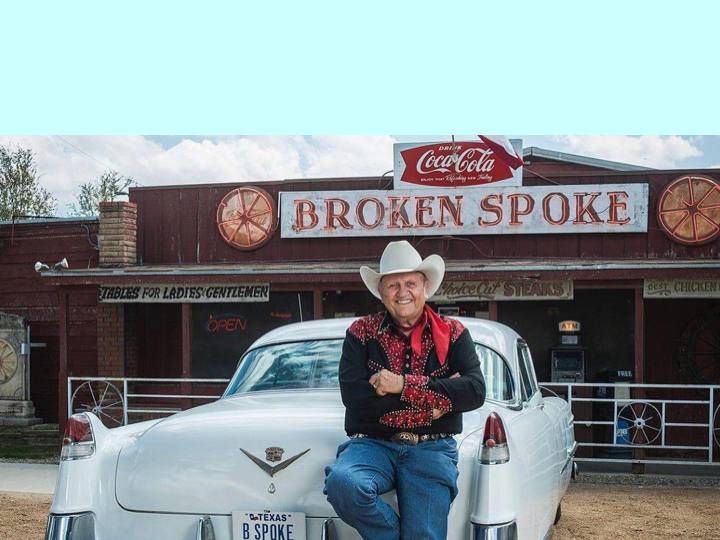
This journey through the “golden years” of the fifties ends in Austin, Texas. There is a reason for that. It is a tribute to a fellow named James White who opened a honky tonk there in the 1930s called the Broken Spoke. This venue hosted nearly every country singer who ever made the big time – Bob Wills, Roy Acuff, Hank Williams, Ray Price, Patsy Cline, Webb Pierce, Jerry Jeff Walker, Johnny Cash, Kitty Wells, Ernest Tubb, Waylon Jennings, Willie Nelson, Charlie Pride, and George Strait, to name a few. This is a place where western swing is IN and line dancing is definitely OUT. James White left for the celestial honky tonk at the end of 2021, but “The Spoke” lives on, amidst the skyscrapers of Austin. Millions of good memories remain for all who have scooted boots in this place. White’s Cadillac is still there.
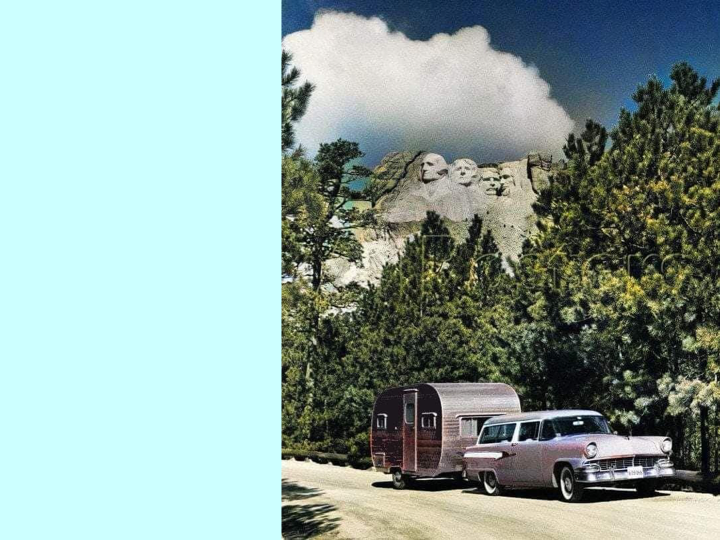
EPILOGUE
Thanks for coming along on this nostalgic tour of thegreatest country on Earth. It has been fun putting a few old photos, some reflections, some facts, and some personal conjectures together. I hope you enjoyed taking a few minutes to flip the pages of this little "magazine" and you let your mind wander along some of the old highways in your past.
I consider myself extremely blessed to have had the opportunity during my time to notonly visit 49 of the 50 states in our Union, but also to actually have a residence, if only temporary, in 17 states. We Americans have an outstanding national home - onethat encompasses 3.7 million square miles where we are more alikew than we are different.
As long as I am able, I will travel this country, preferably in a vintage car befitting mu vintage old body, mind and soul. If the hghways call you, too - perhaps we'll meet someplace along the way.
Terry
Thanks for coming along on this nostalgic tour of thegreatest country on Earth. It has been fun putting a few old photos, some reflections, some facts, and some personal conjectures together. I hope you enjoyed taking a few minutes to flip the pages of this little "magazine" and you let your mind wander along some of the old highways in your past.
I consider myself extremely blessed to have had the opportunity during my time to notonly visit 49 of the 50 states in our Union, but also to actually have a residence, if only temporary, in 17 states. We Americans have an outstanding national home - onethat encompasses 3.7 million square miles where we are more alikew than we are different.
As long as I am able, I will travel this country, preferably in a vintage car befitting mu vintage old body, mind and soul. If the hghways call you, too - perhaps we'll meet someplace along the way.
Terry